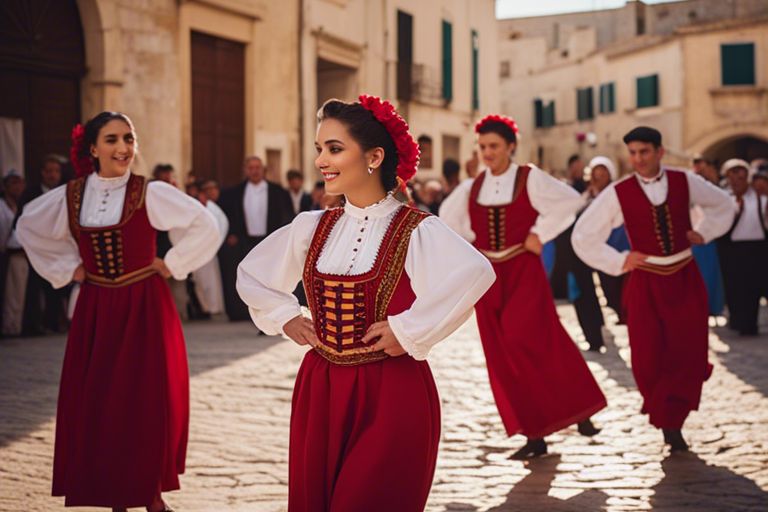Malta’s Traditional Music and Dance

You might have heard of #Malta’s stunning beaches and rich history, but have you explored the vibrant world of its traditional #music and dance? In this guide, we will take you on a journey through the rhythmic sounds and captivating movements that define Malta’s #culturalidentity. Prepare to immerse yourself in the unique #melodies and energetic dances that have been passed down through generations.
From the spirited rhythms of the Ġożitanija to the graceful movements of the Festa Dancers, Malta’s traditional music and dance forms are as diverse as they are fascinating. We will explore the intricate steps and vibrant costumes that make each performance a feast for the senses. Whether you’re a seasoned dancer or a curious traveler, this guide will provide you with insightful tips on where to experience the best of Malta’s traditional music and dance.
Join us as we uncover the hidden gems of Malta’s cultural scene and explore into the passionate world of its traditional music and dance. Get ready to be swept off your feet by the exhilarating beats and captivating choreography that distinguish Maltese performances. By the end of this guide, you’ll be well-equipped to fully immerse yourself in the rich tapestry of Malta’s traditional music and dance.
The Historical Roots of Maltese Music
Prehistoric Echoes: The Origins
Before the arrival of any known settlers, Malta was inhabited by a civilization that left behind a legacy of megalithic temples. These temples, such as the Ggantija Temples on Gozo, are among the oldest free-standing structures in the world, dating back to 3600 BC. While the purpose of these temples remains shrouded in mystery, they are believed to have been sites of religious worship and community gatherings. This prehistoric period likely had a significant influence on the musical traditions that would later develop on the islands.
The unique fusion of cultures that Malta has been exposed to throughout its history has contributed to the rich tapestry of traditional music and dance forms that exist today. From Phoenician, Roman, and Arab influences to the more recent British colonial period, each era has left its mark on Maltese music. The resilient spirit of the Maltese people has allowed them to preserve and celebrate these diverse musical influences, creating a vibrant and dynamic cultural heritage.
The Maltese archipelago’s strategic location in the heart of the Mediterranean has made it a melting pot of musical influences throughout the centuries. This geographical position, coupled with the island’s tumultuous history, has shaped the development of Maltese music into a harmonious blend of traditional and modern elements. From folk songs and dances to religious hymns and festa music, Malta’s musical landscape is as diverse as its history.
The Knights of St. John Era: A Musical Influence
The arrival of the Knights of St. John in Malta in 1530 brought with it a profound influence on the island’s music scene. The knights, who were known for their military prowess and religious devotion, also had a deep appreciation for the arts. They introduced new instruments, such as the double-reed shawm, which became a staple in Maltese folk music. The knights also organized lavish festivals and pageants where music played a central role, further enriching Malta’s musical heritage.
Influence: The Knights of St. John’s influence on Maltese music extended beyond their own presence on the islands. They brought with them European musical traditions that would integrate with local styles, creating a unique fusion that is still evident in Maltese music today. The grandeur and sophistication of the Knights’ musical performances set a high standard that would influence Maltese music for centuries to come.
British Colonial Period and Its Impact
During the British colonial period in Malta, which lasted from 1800 to 1964, the islands experienced a significant cultural shift. British military bands and social clubs introduced new musical genres, such as brass band music and ballroom dancing, to the Maltese population. These new influences coexisted with traditional Maltese music, resulting in a vibrant and eclectic musical landscape that continues to evolve to this day.
Influence: The British colonial period left a lasting impact on Maltese music, introducing new instruments, dance styles, and genres that would shape the local music scene for generations. The fusion of British and Maltese musical traditions created a unique sound that embodied the cultural diversity of the islands. Today, elements of British colonial music can still be heard in Maltese folk music, reflecting the enduring legacy of this historical period.
Traditional Maltese Music Genres
Folk Music: Għana and Its Variations
The Maltese folk music tradition is deeply rooted in the art of storytelling through music. One of the most iconic and cherished forms of Maltese folk music is Għana, which means ‘song’ in Maltese. Għana is a unique type of folk music characterized by its impromptu lyrical improvisation, often performed a cappella. This traditional style of music has been passed down through generations, with themes of love, politics, and daily life prevalent in its verses.
Għana has several variations, including Għana Spirtu Pront, where the singer responds to the audience with quick-witted verses, and Għana Tal-Fatt, which focuses on real-life stories and events. The lyrical content is usually in Maltese or a mix of Maltese and Italian, reflecting the country’s linguistic heritage. Accompanied by guitar, violin, or tambourine, Għana is not only a musical performance but also a cultural expression of the Maltese identity.
Today, Għana continues to thrive in local festivals, celebrations, and gatherings, keeping the rich tradition alive and preserving Malta’s cultural heritage for future generations to appreciate and enjoy.
Band Clubs and Festa Music
To experience the vibrant musical scene in Malta, one must attend the beloved Band Clubs and Festa celebrations. These gatherings are central to Maltese culture and are characterized by the lively sounds of brass bands, depicting a sense of community and festivity. Band Clubs play a significant role in Maltese society, fostering a sense of unity and pride among locals.
Band Clubs often accompany religious processions during village feasts, adding a jubilant atmosphere with their energetic performances. The music played by the bands ranges from traditional marches to popular tunes, creating a dynamic and engaging experience for all attendees. The festive spirit, colorful decorations, and spirited music make Band Clubs and Festa celebrations a must-see cultural experience in Malta.
With a history dating back centuries, Band Clubs and Festa music have become synonymous with Maltese tradition and are a testament to the enduring passion for music and community cohesion on the island.
The Religious Chant of Cantilena
Folk music in Malta is not limited to secular themes but also encompasses religious chants, such as the solemn and spiritually enriching Cantilena. This sacred form of music is deeply rooted in Malta’s religious practices and is often performed during church services and religious processions. Cantilena is characterized by its haunting melodies and solemn tones, creating a sense of reverence and devotion among listeners.
The Religious Chant of Cantilena plays a vital role in the religious rituals and traditions of Malta, enhancing the spiritual experience and connecting worshippers through the power of music. Its profound influence on Maltese culture is evident in the way it accompanies significant religious events and ceremonies, uniting the community in prayer and reflection.
With its intricacies and emotional depth, Cantilena stands as a unique and cherished form of musical expression in Malta, bridging the gap between spirituality and artistry and enriching the cultural tapestry of the island.
The Instruments of Maltese Melodies
Il-Ġuħa and the Maltese Bagpipe Tradition
Keep your ears open as you wander the streets of Malta, and you may catch the melodious sound of the ġuħa. This traditional Maltese bagpipe has a long history dating back centuries and is an integral part of the island’s musical heritage. The ġuħa is a unique instrument with a distinct sound that adds a special touch to Maltese folk music. Musicians playing the ġuħa often accompany dancers during traditional performances, bringing the sounds of the past to life in the present.
Some believe that the ġuħa has its roots in North Africa, making it a significant cultural symbol of Malta’s diverse history. The instrument consists of a sheepskin bag, a chanter, and two drones, creating a rich and vibrant sound that resonates through the air. The ġuħa requires skill and precision to play, with musicians using a combination of fingers and bellows to produce the haunting melodies that define Maltese folk music.
Malta’s bagpipe tradition is a cherished art form that has been passed down through generations. Today, musicians continue to keep the spirit of the ġuħa alive, ensuring that this iconic instrument remains a vital part of Malta’s cultural identity.
Stringed Stories: The Żaqq and Maltese Lira
Assuming the role of storytellers, the Żaqq and Maltese lira are stringed instruments that weave tales through music. The Żaqq, a traditional Maltese percussion instrument, produces a rhythmic beat that accompanies dancers as they move to the music. Its unique sound adds depth to Maltese folk performances, evoking a sense of tradition and history.
It is said that the Maltese lira, a small fretted string instrument resembling a guitar, was introduced to Malta by the Sicilians in the 16th century. The traditional Maltese lira has three strings and is played with a pick, creating a melodic sound that is both enchanting and captivating. Today, these stringed instruments continue to play a vital role in preserving Malta’s musical heritage.
Percussion and Rhythm: The Tambourine and Ċuqlajta
Any discussion of Maltese music would be incomplete without mentioning the tambourine and ċuqlajta, percussion instruments that provide the heartbeat of traditional Maltese melodies. The tambourine, a circular frame drum with jingles, adds a rhythmic dimension to Maltese music, with musicians often using it to set the pace for dancers during performances.
Instruments such as the ċuqlajta, a wooden rattle, contribute to the energetic and lively atmosphere of Maltese music, enhancing the overall experience for both musicians and listeners alike. These percussion instruments play a crucial role in maintaining the rhythm and tempo of traditional Maltese music, ensuring that every performance is filled with vitality and spirit.
The Evolution of Dance in Malta
Folk Dances: The Legacy of the Maltese Community
Many traditional Maltese dances have been passed down through generations, embodying the spirit and heritage of the Maltese people. These folk dances hold a special place in the hearts of the community, showcasing a blend of influences from various cultures that have shaped Malta over the centuries. The lively movements and colorful costumes of the dances reflect the deep-rooted traditions and values of the Maltese society. Each dance tells a story, whether it’s celebrating a harvest, a wedding, or simply the joy of life.
Bridging Tradition and Modernity: Contemporary Influences
While traditional Maltese dances have a rich history, contemporary influences have also made their mark on the dance scene in Malta. Today, dancers are exploring new ways to incorporate modern elements into traditional dances, creating a fusion that appeals to a wider audience. Young dancers are infusing traditional routines with fresh choreography and music, breathing new life into age-old traditions. This blend of tradition and modernity adds an exciting dimension to Maltese dance performances.
Influences such as global dance trends and pop culture have also played a role in shaping the evolution of Maltese dance. From hip-hop and jazz to Latin and ballroom styles, these influences have inspired Maltese dancers to experiment with new forms of expression while still honoring their heritage. The result is a dynamic dance scene that continues to evolve and captivate both locals and visitors alike.
The Role of Dance in Maltese Festivities
If there’s one thing that unites the people of Malta, it’s their love for dance during local festivities. Dance is an integral part of Maltese celebrations, whether it’s a village feast, a religious procession, or a national holiday. The rhythm of the music and the coordinated movements of the dancers create a sense of community and togetherness, inviting everyone to join in the joyous festivities.
A Step-by-Step Guide to Maltese Dance
Your journey into the world of Maltese dance begins with mastering the basics of posture and footwork. The traditional dances of Malta require a strong foundation in these aspects to truly capture the essence of the culture. Let’s break down the importants in the table below:
| Learning the Basics: Posture and Footwork | Details |
| Posture | Keep your back straight, shoulders relaxed, and chin up to exude confidence and elegance. |
| Footwork | Master the intricate steps and movements that characterize Maltese dance, ensuring precision and grace in every motion. |
Learning the Basics: Posture and Footwork
Clearly, mastering the right posture and footwork is crucial in Maltese dance. Training your body to maintain the correct posture will not only enhance your performance but also prevent injuries. Focus on the intricate footwork, which forms the core of Maltese traditional dances. Practicing these fundamental elements diligently will set a strong foundation for your journey into the captivating world of Maltese dance.
Traditional Dance Steps: Maltija and the Legen
Footwork plays a vital role in capturing the essence of Maltese dance. Traditional steps like the ‘Maltija’ and ‘Legen’ require intricate foot movements that showcase agility and rhythm. The fusion of these steps with graceful arm motions and lively music creates a mesmerizing performance that embodies the rich cultural heritage of Malta. Embrace the challenge of mastering these steps to truly immerse yourself in the spirit of Maltese dance.
Plus, traditional Maltese dance steps are not just about the footwork; they also reflect the storytelling and emotions embedded in the movements. Each step has a specific meaning or symbolizes a particular aspect of Maltese history or daily life. Understanding the significance behind these steps adds depth and authenticity to your performance, allowing you to connect with the audience on a profound level.
Dressing the Part: Traditional Costumes and Their Significance
Some of the most important elements of Maltese dance are the traditional costumes worn during performances. These intricately designed outfits play a significant role in preserving the cultural identity and heritage of Malta. From the colorful skirts of the women to the embroidered waistcoats of the men, each costume reflects the traditional attire worn by Maltese villagers for centuries.
Maltija, the traditional Maltese costume, showcases a unique blend of influences from Malta’s history, including elements from the Arab, Sicilian, and Spanish cultures. The elaborate designs and vibrant colors of the attire add to the visual spectacle of Maltese dance performances, transporting both dancers and audiences to a bygone era filled with tradition and elegance.
Preserving Maltese Musical Culture
The Role of Education in Sustaining Traditions
To preserve Malta’s rich musical heritage, education plays a crucial role. Little Maltese children are exposed to traditional music and dance through school programs that incorporate these elements into their curriculum. By teaching the younger generations about their cultural heritage from an early age, there is a higher likelihood of these traditions being sustained and passed down through the years. Additionally, workshops and classes focusing on Maltese music and dance are offered to both locals and tourists, further spreading knowledge and appreciation for these art forms.
Festivals and Celebrations: Keeping the Flame Alive
Festivals and celebrations play a vital role in keeping Malta’s musical culture alive and thriving. Events such as the Maltese Jazz Festival, Marsovin Summer Wine Festival, and the Malta Arts Festival not only showcase traditional music but also provide a platform for contemporary Maltese artists to share their work. These festivals bring people together to celebrate their heritage through music and dance, creating a sense of community and pride in their cultural identity.
Maltesevillages also host local feasts and celebrations where traditional music and dance are prominently featured. These events serve as a reminder of Malta’s rich musical history and allow for the intergenerational transmission of traditions. By incorporating music and dance into societal gatherings, the Maltese people ensure that their cultural heritage remains at the heart of their communities.
Challenges and Strategies in Modern Times
Nowadays, Maltese traditional music faces challenges in the modern world, where global influences can easily overshadow local traditions. One of the primary obstacles is the risk of cultural homogenization, where traditional Maltese music and dance may be diluted or lost amidst the influx of international music styles. To combat this, efforts are being made to create awareness and appreciation for Maltese traditional music through events, recordings, and educational programs.
Plus, the digital age has provided opportunities to preserve and promote Maltese musical culture on a broader scale. Online platforms and streaming services allow for the dissemination of traditional Maltese music to a global audience, ensuring its continued relevance and longevity. By embracing technology while staying true to their roots, the Maltese people can safeguard their musical heritage for future generations to cherish and enjoy.
Experiencing Maltese Music and Dance as a Visitor
Festival Guide: When and Where to Experience the Best
Not only is Malta known for its stunning architecture and beautiful beaches, but it also hosts a variety of vibrant music and dance festivals throughout the year. If you’re visiting Malta and would like to immerse yourself in the local culture, attending one of these festivals is a must-do. The Malta Jazz Festival, held in July, brings together local and international jazz artists for a weekend of world-class performances. For those interested in folk music and dance, the Għanafest in June showcases traditional Maltese music in a picturesque setting overlooking the sea. The Farsons Beer Festival in July is not just about the beer – it also features live music performances from local bands and artists. After indulging in some savory traditional Maltese dishes, you can join the locals in a lively dance known as the ‘Festa Frawli’.
Participation Tips for the Enthusiastic Tourist
Even if you’re not a professional dancer, don’t hesitate to join in the fun during traditional Maltese dance performances. It’s all about immersing yourself in the culture and enjoying the experience. Look for dance workshops or participate in a street parade during one of the lively village feasts. Don’t worry about getting the steps perfect – the locals will appreciate your enthusiasm and willingness to participate. To make the most of your experience, consider learning a few basic Maltese dance steps before your visit. Practice the ‘Festa Frawli’, a popular traditional dance, and don’t be afraid to ask locals for tips and guidance. After all, the key is to enjoy yourself and embrace the local customs.
Language and Etiquette: Respecting the Culture
To fully appreciate Maltese music and dance, it’s important to respect the local language and customs. While English is widely spoken in Malta, it can be helpful to learn a few basic phrases in Maltese to show your appreciation for the culture. When attending a music or dance performance, be respectful of the performers and audience by refraining from talking or making excessive noise. For those attending village feasts or traditional events, dress modestly and observe any cultural etiquette specific to the occasion. It’s important to show respect for the local traditions and customs, as this will enhance your overall experience and leave a positive impression on the Maltese people.
The Pros and Cons of Modern Influences on Traditional Music and Dance
Despite the benefits modern influences can bring to traditional music and dance, there are also drawbacks to consider. Below is a breakdown of the pros and cons of modern influences on these traditional arts:
| Pros | Cons |
| Introduction of new instruments and technologies | Risk of losing authenticity and cultural identity |
| Increased exposure and popularity | Over-commercialization and dilution of traditions |
| Fusion of different music genres for innovative creations | Traditional practices being overshadowed by modern trends |
| Opportunities for collaboration with international artists | Lack of preservation of original forms and techniques |
Factors Contributing to the Evolution of Traditional Arts
Now, let’s explore the factors that have contributed to the evolution of traditional music and dance in Malta.
- Globalization: Exposure to diverse cultures and influences.
- Technological advancements: Use of modern tools in performances.
- Changing demographics: Shifting audience preferences and demographics.
Perceiving these factors is crucial in understanding how traditional arts have adapted to the modern world.
The Positive Blend of Past and Present
Positive evolution occurs when traditional music and dance embrace modern influences without compromising their roots. This fusion creates a dynamic and engaging cultural experience that resonates with audiences young and old. The seamless integration of traditional elements with contemporary styles breathes new life into these art forms, ensuring their relevance in today’s society. By respecting the past while embracing the present, traditional music and dance can thrive and evolve in a way that keeps them authentic yet accessible.
The Risks of Diluting Authenticity
Diluting the authenticity of traditional music and dance poses significant risks to their heritage and legacy. When modern influences overshadow the traditional essence, the soul and uniqueness of these art forms can be compromised, leading to a loss of cultural identity and connection to Malta’s rich history. Evolution is vital for any art form to survive and thrive, but striking a delicate balance between innovation and preservation is key to safeguarding the authenticity of traditional music and dance. It is crucial to protect these cultural treasures from being diluted to the point of losing their essence and value.
How to Support and Promote Maltese Traditional Music and Dance
Tips for Engaging with Local Artists
After immersing yourself in the vibrant world of Maltese traditional music and dance, consider ways to support and promote local artists. Attend performances and workshops to show your appreciation for their craft. Connect with musicians and dancers after shows to express your admiration for their talent and dedication to keeping Malta’s cultural heritage alive. Collaborate with artists on projects or initiatives that showcase their skills and bring greater visibility to Maltese traditions. After establishing relationships with local artists, consider inviting them to participate in events or performances in other locations to expand their reach and audience. Any individual passionate about preserving and promoting Maltese traditional music and dance can support local artists by becoming a patron or sponsor. This could involve funding performance opportunities, recording projects, or cultural preservation initiatives. Engaging with artists on social media platforms, sharing their work with your network, and helping to organize events can also significantly contribute to raising awareness and appreciation for Malta’s rich cultural heritage. After building a supportive network around local artists, explore opportunities for collaborations with other cultural organizations or institutions to further elevate Malta’s traditional arts scene.
Step-by-Step Guide to Organizing Cultural Events
Local enthusiasts looking to organize cultural events centered around Maltese traditional music and dance can follow a structured approach to ensure successful and impactful gatherings. Below is a step-by-step guide to organizing such events:
| Step 1: Define the purpose and theme of the event | Step 2: Secure a venue and date for the event |
| Step 3: Identify and invite local artists to participate | Step 4: Promote the event through traditional and digital channels |
| Step 5: Coordinate logistics such as sound systems, seating, and refreshments | Step 6: Execute the event smoothly and engage with the audience |
Local organizers can enhance the impact of cultural events by collaborating with artists, cultural institutions, and community groups to create a diverse and engaging program that celebrates Malta’s traditional arts. By adhering to the step-by-step guide and seeking support from local stakeholders, organizers can ensure the success and longevity of cultural events that promote Maltese heritage.
Leveraging Social Media and Online Platforms for Global Awareness
Traditional Maltese music and dance enthusiasts can leverage social media and online platforms to boost global awareness and appreciation for Malta’s cultural traditions. By sharing performances, workshops, and insights from local artists on various digital channels, individuals can reach a wider audience and attract international interest in Maltese traditional arts. Engaging with online communities dedicated to world music and dance can also help promote cross-cultural exchanges and collaborations that elevate Malta’s cultural profile on a global scale. Guide your efforts in leveraging social media and online platforms for Maltese traditional music and dance by creating engaging content that highlights the uniqueness and beauty of Malta’s cultural expressions. Utilize platforms like YouTube, Facebook, Instagram, and TikTok to showcase performances, tutorials, and behind-the-scenes glimpses of local artists in action. By engaging with audiences worldwide and fostering connections with individuals who appreciate diverse cultural experiences, you can contribute to the preservation and promotion of Malta’s traditional arts beyond geographical boundaries.
FAQs
What are some traditional Maltese dances I can experience?
Traditional Maltese dances include the energetic Ġożitanija and the graceful Festa Dancers, each with unique steps and vibrant costumes.
How did the Knights of St. John influence Maltese music?
The Knights introduced new instruments and European musical traditions, creating a unique fusion with local styles that enriched Malta’s musical heritage.
What is Għana and how is it performed?
Għana is a traditional Maltese folk music characterized by lyrical improvisation, often performed a cappella, with themes of love, politics, and daily life.
Where can I experience traditional Maltese music and dance?
Traditional music and dance can be experienced at local festivals, Band Clubs, and Festa celebrations throughout Malta.
What are some traditional Maltese musical instruments?
Traditional Maltese instruments include the ġuħa (bagpipe), Żaqq (stringed instrument), tambourine, and ċuqlajta (wooden rattle), each contributing to the island’s unique musical sound.
Recommended Posts

Navigating Malta’s Business Tax Laws
June 28, 2024

Malta for Digital Nomads
June 28, 2024

iGaming: Europe’s Top Betting Destinations
June 28, 2024




